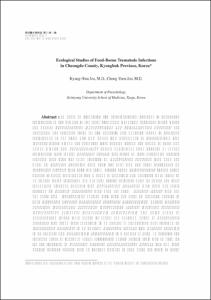Ecological Studies of Food-Borne Trematode Infections in Cheongdo County, Kyongbuk Province, Korea
- Keimyung Author(s)
- Joo, Chong Yoon
- Department
- Dept. of Medical Genetics (의학유전학)
- Journal Title
- Keimyung Medical Journal
- Issued Date
- 2002
- Volume
- 21
- Issue
- 2
- Keyword
- Centrocestus armatus; Clinostomum complanatum; Clonorchis sinensis; Cyathocotyle orientalis; Digenetic larval trematode; Echnochasmus species; Exorchis oviformis; Metacercarial burden; Metacercaria hasegawai; Metagonimus species; Metorchis orientalis; Parafossarulus manchouricus; Semisulcospira libertina
- Abstract
- In order to determine the epidemiological patterns of fish-borne
trematodes in the vicinity of the river Cheongdo, Kyongbuk Province, Korea where
the snails, Parafossarulus manchourichus and Semisulcospira libertina, are
abundant, the infection rates for the cercarial and encysted larvae of digenetic
trematodes in the snail and fish hosts, and prevalence of Clonorchiasis and
Metagonimiasis among the residents were studied during the period of 1998 and
2002. Among the Parafossarulus snails examined, four species of larval
trematodes were found; Loxogenes liberum was found to most frequently liberate
cercaria with 1.81 per cent, followed by Cyathocotyle orientalis with 0.88 per
cent, by Exorchis oviformis with 0.34 per cent and the least frequently by
Clonorchis sinensis with 0.19 per cent. Among 2,179 Semisulcospira snails, seven
species of larval trematodes and 3 kinds of undetermined cercariae were found in
85 snails, which comprises 3.9 per cent overall infection rate. Of these, the most
frequently emerged cercaria was Cyathocotyle orientalis with 1.37 per cent,
followed by Cercaria nipponensis with 0.55 per cent, Cercaria incerta with 0.5
per cent, and Metagonimus species with 0.41 per cent. In nineteen species of
fish, Clonorchis sinensis, Cyathocotyle orientalis, Echnochasmus species Exorchis
oviformis, Metacercaria hasegawai, Metagonimus species, Metorchis orientalis,
Centrocestus armatus, Clinostomum complanatum and some kinds of
undetermined larvae were found. Of these, the encysted larvae of Cyathocotyle
orientalis was found most fequently in 18 species of fresh-water fish, followed by
Metacercaria hasegawai in 17 species, Clonorchis sinensis and Exorchis oviformis
in 12 species, and Clinostomum complanatum in 8 species of fish. In general, the
infection rates of digenetic larval trematodes varied greatly from fish to fish. As
for the intensity of Clonorchis sinensis, Sarcocheilichthys wakiyae was the most
heavily infected species with on average number of 42.8 cysts per gram of flesh, followed by Gnathopogon atromaculatus with 42.7 and Pungtungia herzi with 17.6
cysts. In the case of Metagonimus infections, the intensity was relatively low and
the average number of cysts varied from 0.01 in Zacco temmincki to 3.9 in
Microphysogobio yaluensis. The intensity of the other digenetic trematodes showed
variations depending on the fishes. The infection rates of Clonorchis sinensis
among the residents in the vicinity of the river Cheongdo were relatively high,
being overall 4.3 per cent with a prevalence of 6.3 per cent in males and 2.5 per
cent in females. The difference in the rates of infection between males and females
was found to be statistically significant (t >2). As for the age-specificity, the rate
was 0.9 per cent in the 10-19 year age group and 5.7 per cent in the 30-39 year
age group. The rate increased as age increased, reaching a maximum of 13.6 per
cent in the 40-49 year age group, followed by a decrease. Regarding the intensity
of Clonorchis infections, approximately 80 per cent of the residents with
clonorchiasis had less than 1,000 eggs per gram of feces. In summary, this study
showed that endemic foci of Clonorchis sinensis exist in the vicinity of the river
Cheongdo and Clonorchiasis and metagonimiasis among the residents are still
highly prevalent.
- Keimyung Author(s)(Kor)
- 주종윤
- Publisher
- Keimyung University School of Medicine
- Citation
- 주경화 and 주종윤. (2002). Ecological Studies of Food-Borne Trematode Infections in Cheongdo County, Kyongbuk Province, Korea. Keimyung Medical Journal, 21(2), 133–154.
- Type
- Article
- Appears in Collections:
- 2. Keimyung Medical Journal (계명의대 학술지) > 2002
1. School of Medicine (의과대학) > Dept. of Medical Genetics (의학유전학)
- 파일 목록
-
-
Download
 21-133.pdf
기타 데이터 / 393.76 kB / Adobe PDF
21-133.pdf
기타 데이터 / 393.76 kB / Adobe PDF
-
Items in Repository are protected by copyright, with all rights reserved, unless otherwise indicated.